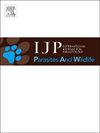Nemabiome sequencing reveals seasonal and age associated patterns of strongyle infection and high prevalence of Strongylus vulgaris in Alberta feral horses
IF 2.2
3区 医学
Q3 ECOLOGY
International Journal for Parasitology-Parasites and Wildlife
Pub Date : 2025-05-28
DOI:10.1016/j.ijppaw.2025.101091
引用次数: 0
Abstract
Unmanaged feral horses, naïve to dewormers, offer a unique opportunity to study natural communities of equine parasites. These communities may include parasites that are rare in managed populations, and these may be transmitted to domestic horses in areas where there is contact between feral and domestic equine populations. There have been only a few studies of gastrointestinal parasite populations in horses, and very few from North American equine populations. This study aimed to gain insights into parasite biology through identification of the strongyle parasite species infecting feral horses in Alberta, Canada, and to test for species-specific infection patterns across season and horse age. Fecal samples (N = 149) were collected from unique individuals in the Sundre Equine Management Zone (EMZ), Alberta, across two years: 2021 (N = 62) and 2022 (N = 87). In 2021, samples were collected in summer (N = 31; 8 foals, 5 subadults, 18 adults) and fall (N = 31; 5 foals, 1 subadult, 25 adults). In 2022, samples were collected in spring (N = 36; 4 subadults, 32 adults), summer (N = 41; 4 foals, 8 subadults, 29 adults), and fall (N = 20; 1 foal, 2 subadults, 17 adults). Fecal egg counts showed that these horses shed high numbers of strongyle eggs relative to domestic horse populations (mean = 1337.01 ± 961.81 epg), and nemabiome analyses identified a total of 34 strongyle species. Species richness and aggregate strongyle FECs were highest in subadults and during the summer, while lowest in foals and during the fall. There was a high prevalence of large strongyle species, especially Strongylus vulgaris (85.91 %), with strongyle species-specific prevalence and FECs strongly associated with age and season. Understanding the factors driving species-specific parasite infection provides important information on strongyle parasite ecology and may aid the development of targeted parasite control strategies.

Nemabiome测序揭示了季节性和年龄相关的圆形线虫感染模式和阿尔伯塔省野马中普通圆形线虫的高流行率
对驱虫者来说,未经管理的野马(naïve)为研究马寄生虫的自然群落提供了一个独特的机会。这些群落可能包括在管理种群中罕见的寄生虫,这些寄生虫可能在野生和家养马种群之间有接触的地区传播给家养马。关于马的胃肠道寄生虫种群的研究很少,而且很少有来自北美马种群的研究。本研究旨在通过鉴定感染加拿大阿尔伯塔省野马的圆形寄生虫物种来深入了解寄生虫生物学,并测试不同季节和马龄的物种特异性感染模式。从阿尔伯塔省圣德雷马管理区(EMZ)的独特个体中收集粪便样本(N = 149),时间为2021年(N = 62)和2022年(N = 87)。2021年夏季采集样本(N = 31;8匹马驹,5匹亚成年马,18匹成年马)和坠落(N = 31;5个小马驹,1个亚成年,25个成年)。2022年春季采集样本(N = 36;亚成虫4只,成虫32只),夏季(N = 41;4头小马驹,8头亚成年马驹,29头成年马驹)和坠落(N = 20;1个小马驹,2个亚成年,17个成年)。粪卵计数显示,这些马的圆形卵数量高于家养马(平均= 1337.01±961.81 epg),线虫组学分析共鉴定出34种圆形卵。物种丰富度和总圆形fes在亚成虫和夏季最高,而在马驹和秋季最低。大型圆线虫的流行率较高,尤以普通圆线虫(85.91%)居多,圆线虫特有的流行率和FECs与年龄和季节密切相关。了解驱动物种特异性寄生虫感染的因素提供了关于圆形寄生虫生态学的重要信息,并可能有助于制定有针对性的寄生虫控制策略。
本文章由计算机程序翻译,如有差异,请以英文原文为准。
求助全文
约1分钟内获得全文
求助全文
来源期刊

International Journal for Parasitology-Parasites and Wildlife
Medicine-Infectious Diseases
CiteScore
3.80
自引率
5.60%
发文量
113
审稿时长
45 days
期刊介绍:
The International Journal for Parasitology: Parasites and Wildlife (IJP-PAW) publishes the results of original research on parasites of all wildlife, invertebrate and vertebrate. This includes free-ranging, wild populations, as well as captive wildlife, semi-domesticated species (e.g. reindeer) and farmed populations of recently domesticated or wild-captured species (e.g. cultured fishes). Articles on all aspects of wildlife parasitology are welcomed including taxonomy, biodiversity and distribution, ecology and epidemiology, population biology and host-parasite relationships. The impact of parasites on the health and conservation of wildlife is seen as an important area covered by the journal especially the potential role of environmental factors, for example climate. Also important to the journal is ''one health'' and the nature of interactions between wildlife, people and domestic animals, including disease emergence and zoonoses.
 求助内容:
求助内容: 应助结果提醒方式:
应助结果提醒方式:


